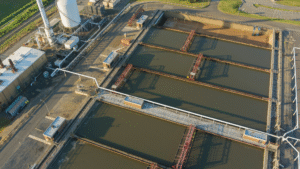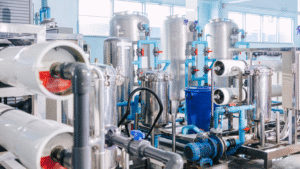Maintaining proper alkalinity in water systems is essential for protecting equipment, ensuring water quality, and supporting effective treatment processes. Water that is too acidic can corrode pipes and machinery, while water that is too alkaline can lead to scale formation and operational inefficiencies. To strike the right balance, water treatment programs often rely on specially formulated alkalinity booster products.
Alkalinity boosters are designed to stabilize pH levels by increasing the water’s buffering capacity, helping it resist sudden shifts that could harm the system or compromise water safety. These products play a critical role across various industries, from water treatment plants and drinking water facilities to swimming pool water systems and industrial processes. By delivering consistent alkalinity levels, they help prevent corrosion, control scale, and support the overall effectiveness of disinfection and filtration methods.
In this article, we explore how stable alkalinity booster formulations are developed, the challenges they address, and how their application benefits water systems in different settings. We’ll also look at how ETI’s expertise helps industries achieve reliable and cost-effective water treatment through advanced booster technologies.
The Role of Alkalinity in Water Treatment
In water treatment, alkalinity refers to the water’s capacity to neutralize acids and maintain a stable pH. This buffering ability is crucial for preventing rapid changes in acidity that could damage equipment, disrupt biological or chemical processes, and reduce the effectiveness of treatment chemicals. Without adequate alkalinity, systems become vulnerable to corrosion, scale buildup, and reduced water quality.
For water treatment plants, alkalinity helps stabilize the pH after the addition of coagulants and disinfectants, ensuring that the water remains safe and palatable for consumers. In drinking water systems, maintaining the right level of alkalinity prevents the water from becoming corrosive, which can lead to the leaching of metals like lead and iron from pipes into the water supply.
Similarly, in swimming pool water, alkalinity helps protect both swimmers and infrastructure. Low alkalinity can result in sharp pH swings, causing eye irritation, corrosion of pool surfaces, and damage to filtration systems. On the other hand, excessive alkalinity can lead to scale deposits, cloudy water, and reduced disinfectant efficiency.
Beyond these examples, alkalinity also plays an essential role in industrial processes by protecting boilers, cooling systems, and process equipment from corrosion and scale, ensuring both efficiency and longevity. The benefits of proper alkalinity control extend to reduced maintenance costs, improved water quality, and a longer lifespan for pipes and machinery.
Challenges in Formulating Stable Alkalinity Boosters
Creating a stable and effective alkalinity booster is more complex than simply adding alkaline chemicals to water. The formulation must remain consistent, safe, and effective under a variety of conditions, while avoiding undesirable reactions with other substances in the system.
One of the primary challenges lies in controlling the compounds and molecules that naturally occur in water. Water can contain common contaminants such as bacteria, toxins, iron, and lead, which may interact with booster chemicals and reduce their effectiveness. For example, in the presence of high levels of calcium or magnesium, poorly designed boosters can react and form larger insoluble particles that settle out of solution, leading to scale or sludge accumulation.
Another challenge is ensuring that the booster does not trigger extreme pH changes. Overly aggressive formulations can overshoot the desired pH range, damaging pipes, reducing disinfection efficiency, or making the water unsafe for its intended use.
Additionally, maintaining long-term stability requires careful attention to the chemicals chosen and how they interact over time. Many basic boosters degrade or precipitate if not properly balanced, especially when exposed to heat, light, or certain substances present in industrial or municipal systems.
For these reasons, effective alkalinity boosters must be carefully engineered to provide consistent buffering capacity without causing secondary problems in the water treatment process.
Key Ingredients and Chemistry Behind Effective Boosters
A well-designed alkalinity booster relies on carefully selected ingredients that not only raise alkalinity but also maintain system stability and safety. The goal is to achieve the desired pH and buffering capacity without introducing unwanted side effects.
Common alkaline chemicals used in booster formulations include sodium carbonate (soda ash), sodium bicarbonate, and sodium hydroxide. These compounds increase alkalinity by neutralizing acids in the water, but each comes with its own advantages and limitations. For example, sodium hydroxide is highly effective but can be corrosive if overdosed, while sodium bicarbonate provides a gentler, more controlled increase.
To improve performance, many boosters incorporate blended buffering agents that prevent rapid pH changes. These blends are especially valuable in sensitive environments such as hot tubs, where overcorrection can damage equipment and irritate users, or in reverse osmosis systems, where scaling risks must be minimized without interfering with membrane performance.
In industrial settings, booster formulations may also include components designed to support coagulation and flocculation, helping to remove suspended particles during filtration. Additives can be tailored to form stable solutions that avoid precipitation and remain effective over time, even in the presence of challenging water chemistries.
Learn more in our blog: Chemical Water Treatment Program Design and Cost Optimization
Best Practices for Application Across Industries
The proper use of an alkalinity booster depends on the specific system and industry it serves. Industrial and municipal applications require tailored approaches to achieve optimal water chemistry, maintain equipment integrity, and protect public health. Below are examples of how alkalinity boosters are applied effectively across different settings.
Municipal Drinking Water Systems
- Boosters help neutralize acidic water to prevent metal leaching from pipes, improving water taste and ensuring a safe source for consumers.
- They stabilize pH to enhance the effectiveness of disinfection processes, such as chlorine and ultraviolet treatments.
- Utilities see improved water quality and regulatory compliance when alkalinity is properly managed.
Industrial Wastewater Treatment
- In wastewater applications, boosters adjust pH to optimize coagulation, flocculation, and sedimentation processes.
- They support the removal of pollutants, carbon, and suspended solids, helping plants meet discharge limits.
- Proper alkalinity control improves sludge settling and reduces chemical waste.
Cooling and Process Water Systems
- In cooling systems, boosters help prevent corrosion and scale control, while maintaining ideal conditions for disinfection chemicals.
- Balanced alkalinity minimizes fouling on heat transfer surfaces and extends equipment life.
- In manufacturing processes, they stabilize pH to protect sensitive equipment and ensure product quality.
By aligning booster application with system demands, water treatment professionals can ensure that their systems remain resilient, efficient, and safe — delivering reliable water quality for both people and industrial processes.
ETI’s Expertise in Alkalinity Boosters
At ETI, we know that maintaining proper alkalinity in industrial water systems is not just about adding a chemical but applying the right chemistry, at the right level, with the right expertise. Our advanced alkalinity booster formulations are designed to meet the specific needs of industrial and municipal systems, ensuring operational reliability, regulatory compliance, and cost efficiency.
We offer alkalinity booster products as part of our broader water treatment portfolio, which also includes comprehensive Cooling & Boiler Treatments. These solutions work together to stabilize pH, protect equipment, and improve overall water quality across your system. From boiler systems that demand high-temperature stability to cooling towers where corrosion and scale must be controlled simultaneously, our products are tailored to deliver reliable results.
When you work with ETI, you gain access to decades of hands-on experience, custom-blended formulations, and the ability to adapt programs as operational changes occur. Every solution we provide is designed to function effectively under your system’s specific conditions, protecting equipment, optimizing performance, and safeguarding water resources.
We invite you to explore our services and learn how ETI can help your operation realize the full benefits of effective alkalinity management:
Alkalinity Boosters: The Foundation of Effective Industrial Water Treatment
Cooling & Boiler Treatments
The Value of Stable Alkalinity Boosters
In industrial and municipal water treatment, maintaining proper alkalinity is one of the most important steps you can take to protect your systems and improve water quality. Stable alkalinity booster products not only buffer pH effectively, but also help prevent corrosion, reduce scale, and support disinfection and contaminant removal processes.
When you invest in properly formulated boosters, you’re making a cost-effective choice that benefits both your equipment and your operations. These solutions are designed for large and complex systems where the addition of the right chemistry ensures reliability, efficiency, and compliance with environmental standards.
At ETI, we’ve helped thousands of customers across industries turn water challenges into stable, sustainable solutions. If you’re ready to turn to a partner who understands the science and the application of advanced water treatment chemistry, visit our service page, or contact us to learn how we can support your goals.
Frequently Asked Questions (FAQs)
How do alkalinity boosters help with contaminant removal?
Alkalinity boosters improve pH stability, which enhances coagulation, flocculation, and filtration processes. This allows substances, molecules, and suspended particles to settle out more effectively, helping to remove contaminants and improve water quality.
Are alkalinity boosters compatible with disinfection methods like ultraviolet or chlorine?
Yes. Properly formulated boosters work alongside disinfection technologies, including ultraviolet light and chlorine, by keeping the pH within the optimal range for these treatments to function effectively.
Do alkalinity boosters impact fluoride levels in drinking water?
No. Boosters adjust pH and buffering capacity but do not directly remove or add fluoride to the water. They’re designed to support safe, balanced drinking water without interfering with regulated additives.
Can ETI provide solutions for plants with large-scale discharge needs?
Absolutely. ETI designs boosters to perform reliably in large facilities, including those facing strict discharge requirements. We account for downstream impacts to ensure compliance and minimize environmental effects.
How does alkalinity management contribute to energy and cost savings?
Stable alkalinity helps systems operate efficiently, reducing wear on equipment and improving heat transfer. This minimizes the electricity required to operate pumps and heat exchangers while keeping maintenance costs predictable.
How can I explore the right solution for my system?
You can contact ETI directly to discuss your system’s needs. Our specialists will guide you through the steps to select a solution tailored to your process and operational goals. Visit our service page to explore your options.





